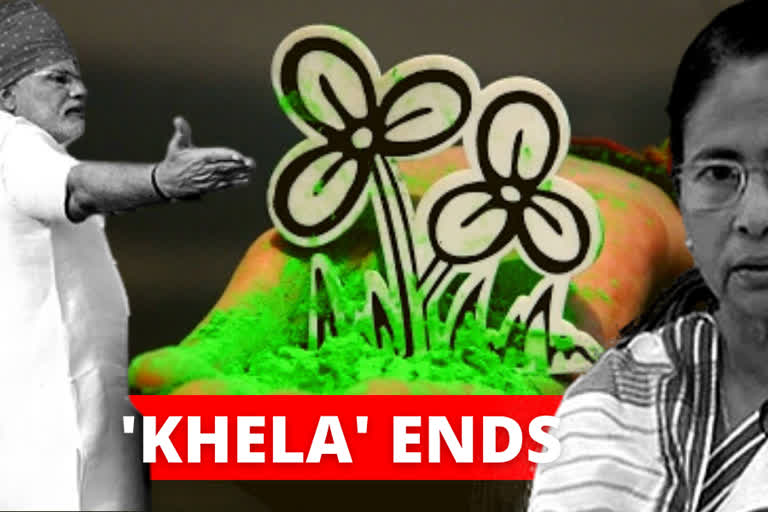Hyderabad: With the Trinamool Congress poised to cruise to a landslide victory in the Assembly elections to return to power for the third time in a row, Chief Minister Mamata Banerjee on Sunday dedicated the win to the people of West Bengal, besides taking a dig at both the Election Commission and the BJP.
However, there seemed to be a setback for the Trinamool supremo in Nandigram, where after several twist-and-turns, her one-time aide Suvendu Adhikari of the BJP defeated her by a narrow margin. However, her role in the election is way impressive than any other as she had contested against her former colleague who holds a good grip over the Nandigram constituency.

She challenged Adhikari- who is one of the most talked-about leaders in West Bengal as he quit the Trinamool Congress after an almost two-decade association and joined the BJP in December the last year-since he apparently felt sidelined with the rise of Mamata Banerjee's nephew Abhishek and some organisational changes.
From Bengal's daughter to nation's Didi
Striving to prove that "Bangla nijer meyekei chaye" (Bengal wants its own daughter), she continues her stride in the political spectrum of the nation that began in 1975 making the headlines by dancing on the car of the most influential leaders of that time Jayaprakash Narayan as a mark of protest.
Forty-six years have passed since then; her fighting spirit continue to shine in Indian politics. She is 'Nation's Didi' Mamata Banerjee. She became the chief minister of West Bengal in 2011 by ending the 34-year-long CPI(M) regime, one of the longest-serving elected governments in the world. Now after ruling the state for two successive terms, the game of thrown of 2021 was not less than a do-or-die situation for her.
It is the Bharatiya Janata Party (BJP) that trespassed her dominion after gaining overwhelming results from the state in the 2019 Lok Sabha polls. And, the emergence of the Left-Congress-ISF alliance made the situation more complicated for her. Mamata endorsed her governance as the rule of three 'M's, that is, 'Maa', 'Mati' and 'Manush' (mother, soil and people). But, the Bengal elections had another 3M factor this time, that is, 'Mamata', 'Modi' and 'Muslim'. So, Mamata's challenge was to counter Prime Minister Narendra Modi's popularity in Bengal at one side and regain her support base of the minority community that was impacted by ISF and stepping in of Asaduddin Owaisi's AIMIM.
READ: Mamata Banerjee remains the most popular leader in West Bengal: CSDS
Making the power battle more interesting, Mamata chose Nandigram over her home turf Bhabanipur seat this time to test her fate in the 2021 elections. It was the agitation in Nandigram and Singur against the Left government's land acquisition policies that made Mamata Banerjee the Chief Minister of West Bengal. Further, Mamata's poll campaign this time got a new dimension with a wheelchair after she suffered an injury in March, 2021 while campaigning in Nandigram. It is worth mentioning that the West Bengal Chief Minister spared no dais to launch scathing attacks on Prime Minister Modi.
However, the Modi-Mamata battle was quite visible even before the 2019 Lok Sabha elections. She played an instrumental role in bringing together all opposition parties against the Centre prior to the 2019 general elections.
The seventh-term MP also has been among the first key figures who heavily criticised the central government in issues starting from demonetisation to Citizenship Amendment Act (CAA) and lockdown to fuel prices. Her fighting spirit and mass appeal have made her one the tallest opposition figures in the current political arena.
Banerjee started her political career as a Youth Congress worker in the 1970s. She quickly rose the ranks and became the general secretary of Mahila Congress and later All India Youth Congress. In 1984 she was elected as a member of parliament in the 8th Lok Sabha becoming one of India's youngest parliamentarians.
She founded the All India Trinamool Congress in 1997 after a disagreement with Congress.
Mamata Banerjee worked with three Prime Ministers including PV Narasimha Rao, Atal Bihari Vajpayee and Dr Manmohan Singh. She had been a Union Minister in both National Democratic Alliance (NDA) and United Progressive Alliance (UPA) governments and held portfolios like Human Resource Development, Youth Affairs and Sports, Women and Child Development, Coal and Mines and the Railways.
Read: WB Assembly polls: Welcome to Didi-land, again
Notably, she was the first woman to become a railway minister in the country. The Time Magazine named her among the 100 most influential people in the world in 2012.
Hailing from a lower-middle-class family, Banerjee worked as a milk booth vendor to battle poverty. Her father passed away due to the lack of treatment when she was just 17.
The fighter in her never let the barriers dominate her. She continued her education and earned a Bachelor's degree in History, a Master's degree in Islamic History and degrees in Education and Law from the University of Calcutta. She also worked as a stenographer and a private tutor before joining full-time politics.
Another disposition of Mamata Banerjee is her minimalist lifestyle.
Despite being the Chief Minister, she still lives in her ancestral terracotta-tiled roof house at Kolkata's Harish Chatterjee Street. White cotton sarees having mono-colour borders and slippers are all that define the fashion statement of Mamata Banerjee.
The West Bengal Chief Minister is also a self-taught painter, poet and writer. She has authored more than 100 books. She is also tech-savvy and remains active on social media. The Trinamool Supremo is also known for her walkathons or marches. Here it needs to be mentioned that she walks five-six kilometres on a treadmill every day. When it comes to evening snack time, she likes to have tea, puffed rice and 'aloo chop'.
(With inputs from agencies)
ALSO READ: Day of disappointment for Congress in Kerala: Tharoor



